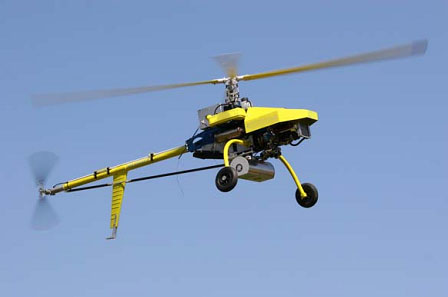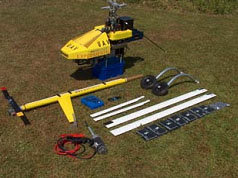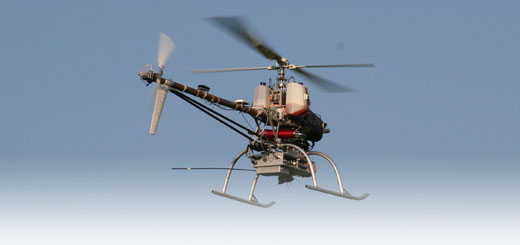


 |
 |
 |
Scout B2

TECHNICAL DATA
Main rotor diameter 3.0 m
Tail rotor diameter 0.6 m
Main rotor speed 690 rpm
Empty weight (no fuel, no payload) 28 kg
Gasoline engine 120 ccm
Engine power (approx.) 12 PS
Electric starter 12V
Fuel tank volume (standard) 3.0 l
Material of rotor blades carbon
Material of body aluminum
Engine cooling system air-cooled
Length 3.1 m
Width 0.5 m
Height (approx.) 1.0 m
Landing gear 2 main wheels, one tail skid
Endurance up to 90min
Speed in manual mode 70km/h
Cruising speed in automatic mode 10m/s (standard)
PAYLOAD DATA
Optional autonomous INS/GPS flight control system 2.0 kg (incl. battery)
Standard fuel tank (approx.) 3.0 kg
Free payload capacity (approx.) 20.0 kg
FEATURES
Air-cooled gasoline engine
Easy transportability and maintainability through modularity
Sealed gear boxes and electronics
Highly reliable mechanical design
Autorotation capability at full load
Optional integrated, autonomous flight control system FCS
Optional (D)GPS/INS integrated navigation system
Flexible payload options
High maneuverability
Smoothly running engine and optimal vibration isolation of the payloadScout B1


GENERAL The autonomous industrial unmanned helicopter Scout B2 has been developed for professional airborne applications such as aerial mapping, airborne broadcasting, search & rescue, surveillance and inspection as well as law enforcement.
PAYLOAD The helicopter provides a payload capacity of 25 kg (incl. 3 l fuel (standard), 2 kg flight control system) with an empty weight of only 28 kg.
SAFETY The helicopter has been developed under severe safety policies, including autorotation capability under full payload, high engine power reserve capacities, mechanic robustness (3x
load excess), and environmental robust against spray water.
FEATURES The Scout B1 provides easy transportability and maintainability through system
modularity, flexible payload options, and a smooth and easy-to-start gasoline engine.
OPERATION The helicopter can either be flown in conventional manual mode with high maneuverability or can be operated with its integrated INS/GPS automated flight control
system. This flight control system allows joystick (velocity) mode as well as waypoint (GPS)
mode.
Scout B2 - Unmanned Aircraft Technology

Aeroscout provides autonomously flying, industrial unmanned helicopters for aerial imagery and photogrammetry, aerial video recording, surveillance and inspection, 3D laser mapping, search & rescue, aerial scientific measurements (online/offline), and many other applications with an airborne robot.
Aeroscout offers different sizes and types of INS/GPS controlled unmanned helicopters (UAV = unmanned aerial vehicle). These UAV helicopter provide a unique payload capacity which can be used for customized solutions and requirements such as digital cameras, video camcorders, laser scanners, or infrared equipment.
In addition, Aeroscout provides services with our products operated by our experienced flight crew for variable applications. In cooperation with clients, Aeroscout develops customized UAV solutions for specific usage.
Aeroscout offers:
General Description of the Scout B1 Helicopter
The Scout B2 helicopter is our latest development of a high performance, industrial built
UAV helicopter. This system is based on an aircraft-tested 120 ccm fuel engine with a power of
up to 18PS. It also provides an integrated electronic starter and an onboard power generator
(approx. 40W, unregulated 12V) for FCS power backup. The system has already been
demonstrated under various weather and temperature conditions, including snow fall (0 degC)
and hot outside temperature (40 degC) applications.
 Scout B2 with snow fall.jpg) |
 Scout B2 under high temperature.jpg) |
(1) Scout B2 with snow fall |
(2) Scout B2 under high temperature |
 Scout B2 before lift-off.jpg) |
 Scout B2 at lift-off.jpg) |
(3) Scout B2 before lift-off |
(4) Scout B2 at lift-off |
 Scout B2 at system delivery.jpg) |
 Scout B2 with 2x5l fuel tank.jpg) |
(5) Scout B2 at system delivery |
(6) Scout B2 with 2x5l fuel tank |
 Scout B2 in flight with the flight control.jpg) |
The helicopter Scout B2 features in particular a modular system structure. This enables on the one hand an optimal maintenance access, and on the other hand a simplified transportability. This helicopter differs basically from other small unmanned helicopters due to its professional and industrial/robust construction.
.jpg) |
.jpg) |
(8) Scout B2 main rotor head |
(9) Scout B2 swash plate with
integrated rpm sensor |
The new main rotor head has been developed in particular for a long reliable UAV mission and is being tested as a completely mounted unit. The helicopter is equipped in its standard configuration with two 5l fuel tanks and an additional payload capacity up to 18-20kg.
.jpg) |
The possible flight endurance depends on the actual flight altitude and the actual payload, the environmental conditions (incl. temperature and wind gusts), and the required flight velocity and can achieve up to 1.5 hours (90 min).
.jpg) |
.jpg) |
(11) Scout B2tail rotor |
(12) Scout B2 tail rotor servo and belt |
.jpg) |
.jpg) |
(13) Scout B2 main rotor mechanics |
(14) Scout B2 engine and connectors |
.jpg) |
The Scout B2 UAV system is provided with its specifically adapted transportation units. One unit is being used for the helicopter main body with additional equipment such as battery chargers, fuel and oil tank. The second unit is being used for the helicopter tail boom together with the main rotor blades and the paddles. All components are well-fixed inside the units.
.jpg) |
Automatic Flight Control System
The flight control system wePilot1000 provides a defined interface for data retrieval and for
reference flight velocity input. The corresponding ground control station software weGCS can
be installed on a standard laptop. This allows flying the helicopter in simple joystick mode
with reference data for the flight velocity or in mission mode by pre-programmed GPS coordinates.
.jpg) |
|
(17) Flight control system wePilot1000 |
(18) Ground control station software weGCS |
The wePilot1000 flight control system includes attitude, velocity, position, and engine speed
control. The flight control system has been used in various Scout B2 UAV systems and the
technical performance has been demonstrated at different occasions.
The understanding of the handling of the Scout B2 UAV system with its integrated flight
control system is part of the system and maintenance training which is in general combined
with the UAV system demonstration and delivery.
Beside the standard functionalities of the wePilot1000 flight control system, Aeroscout
provides additional features such as data recording, data processing, and payload interface
programming.
Main characteristics of the Scout B2 flight control system (autopilot)
- Flying modes
a) manual override
b) assisted/satbilized flight mode (reference velocity input with keyboard,
radio, serial interface or joystick)
c) fully automatic flight mode (velocity and position reference input based on
GPS flight coordinates)
- Maximum waypoints: 255
- Maximum cruising speed in automatic mode:
a) 10m/s (forward)
b) 4m/s (sideward)
c) 2m/s (vertical)
- Lift-off and landing: fully automatic
- Data download interface for data post-processing
- Host interface for convenient system configuration
- customizable digital and analog I/O interface
- serial data interface (RS-232) for navigation data output at 50Hz with GPS time stamp
- Extended Kalman filter for navigation data fusion
Ground Control Station (optional GPS reference station)
The ground control station includes on the one hand the manual backup radio and on the
other hand the computer/laptop with the installation of the software package weGCS for
mission planning and status display.
The differential GPS station for higher position accuracy of the UAV system is optional and not
part of the standard UAV system delivery. The actual flight data is also provided onboard on a
serial connection based on a standardized data protocol.
-2.jpg) -1.jpg) |
-1.jpg) -2.jpg) |
.jpg) |
.jpg) |
.jpg) |
Scout B1 UAV System Features
Automatic lift-off can be started by the operator at the ground station with the keyboard
commands “ctrl-t” (take-off) or by the manual backup pilot by switching to the autopilot mode
which will then be interpreted as a lift-off command.
Landing will be started by the operator at the GCS with the keyboard commands “ctrl-l”
(landing). The helicopter will land softly and touch the ground. If the minimum collective pitch
angle of the main rotor blades is achieved, the engine will be turned off automatically or the
engine can be turned of by the operator with the commands “alt-o” (engine off).
If the data link fails, the UAV will interrupt its mission after a certain time (can be selected by
the customer before system delivery) and will go to hover flight. After another time period the
helicopter will start his “homing” flight. After another time period, the helicopter will land
automatically at the “home” point which was defined within the mission.
Emergency shut-down is given with the “ctrl-l” (landing) or “alt-o” (engine-off) command. The
manual backup pilot can always override the flight control system and stop the engine with the
radio switch (shut-down).